Seafood & Andouille Gumbo
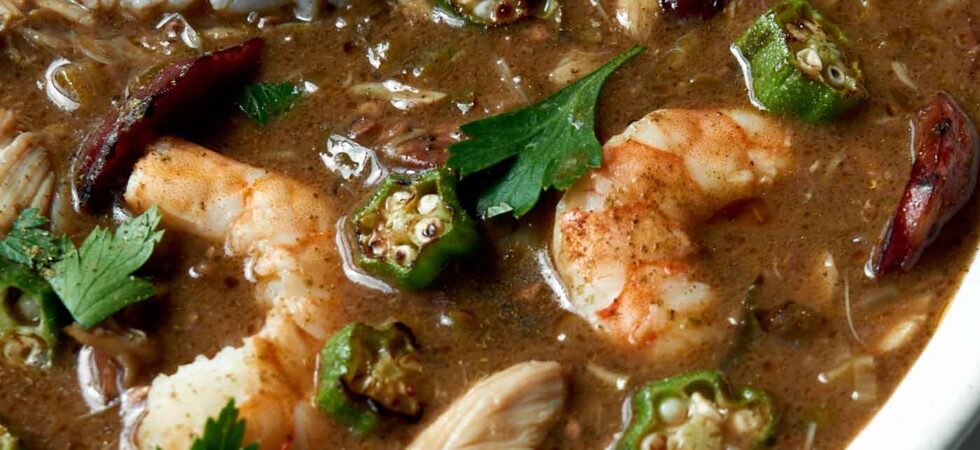
One of the first stews I make during the transition between summer and fall is Seafood & Andouille Gumbo. It’s bursting with flavor and uses late summer crops like okra and green peppers. With a lighter seafood and chicken stock base, this stew is the perfect start for soup season.
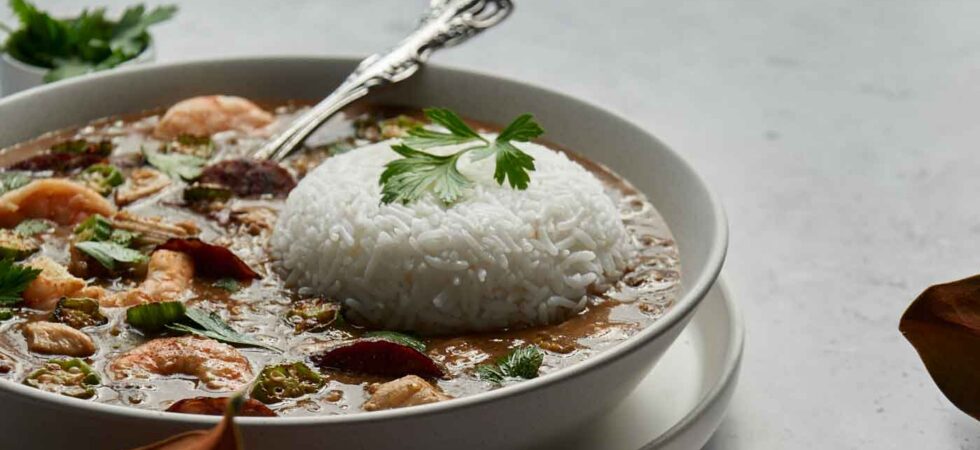
Get the Recipe: Seafood & Andouille Gumbo
Ingredients
Shrimp Stock
- 8 cups water
- 2½ lbs medium shrimp , heads and shells on
- 3 carrots
- 4 celery stalks
- ½ onion
- 1 bay leaf
- ½ tablespoon whole peppercorns
- ½ teaspoon dried thyme
- 2 cloves garlic, crushed
- ½ a lemon
Chicken Stock
- 8 cups water
- 1 cut up rotisserie or roasted chicken carcass with as much skin as you can keep
- 3 carrots
- 4 celery stalks
- ½ onion
- 1 bay leaf
- ½ tablespoon whole peppercorns
- ½ teaspoon coriander seeds
- 2 cloves garlic, crushed
- ½ a lemon
Gumbo
- 2 medium onions, small dice
- 2 green peppers, small dice
- 4-5 celery ribs, small dice
- ¾ cup green onions, sliced
- ¼ teaspoon cumin, toasted and ground
- ½ teaspoon paprika
- 1 teaspoon black pepper, fresh ground
- ⅛ teaspoon celery seed
- ½ teaspoon white miso paste
- 1 anchovy
- 4 cloves roasted garlic
- 1½ lb or 7 cups fresh okra, sliced
- 1½ lbs andouille sausage
- 1 lb smoked sausage
- 1½ cup all purpose flour
- 1 cup canola or vegetable oil
- ½ tablespoon kosher salt
- 1 cup amber ale
- 6 cup shrimp stock
- 2 cup chicken stock
- 1 lb crab meat
- 2 teaspoon Crystal River hot sauce
- 1 teaspoon fresh thyme
- ½ tablespoon gumbo filé
- 1 lb Shrimp, peeled/deveined
- 1 tablespoon vodka (optional)
Equipment
- 1 chef knife
- 1 cutting board
- 1 colander
- 1 mixing bowls
- Measuring spoons
- measuring Cups
- 1 enameled dutch oven
- 1 flat-tipped, wooden spoon
Instructions
- First make the stocks. For the chicken stock, break down the chicken with a boning knife and add in the rest of the ingredients into a stock pot. Bring everything to a gentle boil, uncovered, for 4-6 hours. Skim off any impurities and foam as it cooks. Strain, separating out 2 cups (480ml) and store in the refrigerator.
- For the shrimp stock, pull off the shrimp heads and shells, placing the shrimp into a bowl and the exoskeletons into a strainer. Once all of them have been peeled, place the bowl of shrimp into the refrigerator and lightly rinse off the heads and peels. Add them to a stock pot with the rest of the ingredients and bring everything to a gentle simmer for 1-2 hours. Skim off any impurities and foam as it cooks. Strain and separate out 6 cups (1.4L) of stock. Store in the refrigerator.
- Next, slice up the okra by taking off the tops and cutting 1/4 inch (.64cm) slices for the remainder of the vegetable. Once cut, heat a large sauté pan on medium high heat. Add about 2 tablespoons of canola oil and then dump in the okra slices. Sautee all of the sliminess out until the okra browns and chars at the edges. It may take up to 30 minutes to get all of the okra dried out. Transfer to a container and set aside.
- Prep the sausage by cutting 1/4-1/2in (.64-1.3cm) slices on the bias, so they are cut diagonally. In the same pan that the okra was cooked in, sauté the sausage until it's crispy with nicely browned spots on both sides. Transfer the sausage and grease to a container and chill in the fridge until it's time to add it back into the gumbo.
- Now is the time to prep all of the other ingredients. Once you start the roux, there is no time to do any chopping or measuring. Cut up the mire proix (onion, peppers, and celery) into 1/4in (cm) cubes and the green onion into 1/4in (cm) slices. Keep them separate and set them each aside. Mash/mix together the roasted garlic, miso paste, and anchovy along with the cumin, paprika, black pepper and celery seed. Also, separately measure out the kosher salt, beer, and stocks into their own containers and have them ready to go.
- To start the roux, add the oil to a heavy bottomed stock pot or enameled dutch oven on a stove top set between med-high and high. Bring the oil’s temperature up until you can smell it. Then, pour in the flour and immediately begin stirring and gently scraping along the bottom and sides of the pot with a wooden spatula. Make sure to never stop stirring or the roux will burn. The flour will go from white to peanut butter to milk chocolate and then dark chocolate color within 15 minutes. It will be smoking a bit, that’s okay, just open a window or turn on your oven hood fan, if you have one.
- Once you have the dark chocolate color roux, add in your onions and stir for 30 seconds, then add in the celery, peppers, and salt. Continue stirring all of this until you see the veggies start to soften. It shouldn’t take longer than 5 minutes. Then toss in the okra and spices/pastes and mix around for 1-2 minutes. Next, pour in the beer. Continue stirring for 2 minutes and then add in the stocks, sausage, crab meat, and bay leaf.
- Let that simmer on low for 4-6 hours. About 30 minutes before the gumbo is done, stir in the crystal hot sauce and fresh thyme. Then, cook the shrimp in the gumbo using a small colander or large mesh strainer. Take the shrimp out and put them in a separate bowl after they cook through. You can then turn off the burner and add in the filé and vodka. Give the gumbo a good stir and then scoop it into a bowl to serve. Make sure to add back in some shrimp to each bowl. Serve topped with rice, chopped parsley, and/or a small sprinkling of additional filé.
Notes
- Making Shrimp Stock: If you cannot find shrimp with the heads still attached, you will need to at least double the shrimp tails to get a similar flavor, but it can be done.
- Making Chicken Stock: Uncooked chicken can be used for a homemade stock, but it won’t be as flavorful. Make a roast chicken or even buy a fresh rotisserie chicken and then use those leftovers for your soup base. Honestly, WORLDS of difference.
- Watch your Roux: You’ll know the roux is burned if you see black flecks or chunks that are much darker than the rest of the roux and it has taken on a bitter, acrid smell.
- Equipment Recommendations: I recommend, using an enameled dutch oven as it holds heat better and won’t have hot spots to scorch your roux like a metal stock pot would. If you are using metal, I suggest keeping everything at medium high and no higher, to be on the safe side. I also recommend using a wooden, flat-tipped spatula. I’ve found that utensils encased in silicone or with many parts, like a whisk, can volatilely affect the surface of the roux causing it to more readily spatter out of the pot. And, let me tell you, oil this hot immediately blisters on impact. No thanks!
- Cooking Shrimp Perfectly: Since you will surely have different sizes of shrimp in your batch let me just give you visuals to look out for. The shrimp should turn pink/orange in color fro their uncooked gray. I know an easy one. They should also never be cooked past a gently curled “C” shape. Once they curl tightly against themselves they are the texture of rubber. Don’t let it get that far. Even if you only put the shrimp in at the very end, that stew is hot. They will over cook in a matter of minutes. Cook them and then set them aside to be added back in at serving for the best texture.
Nutrition
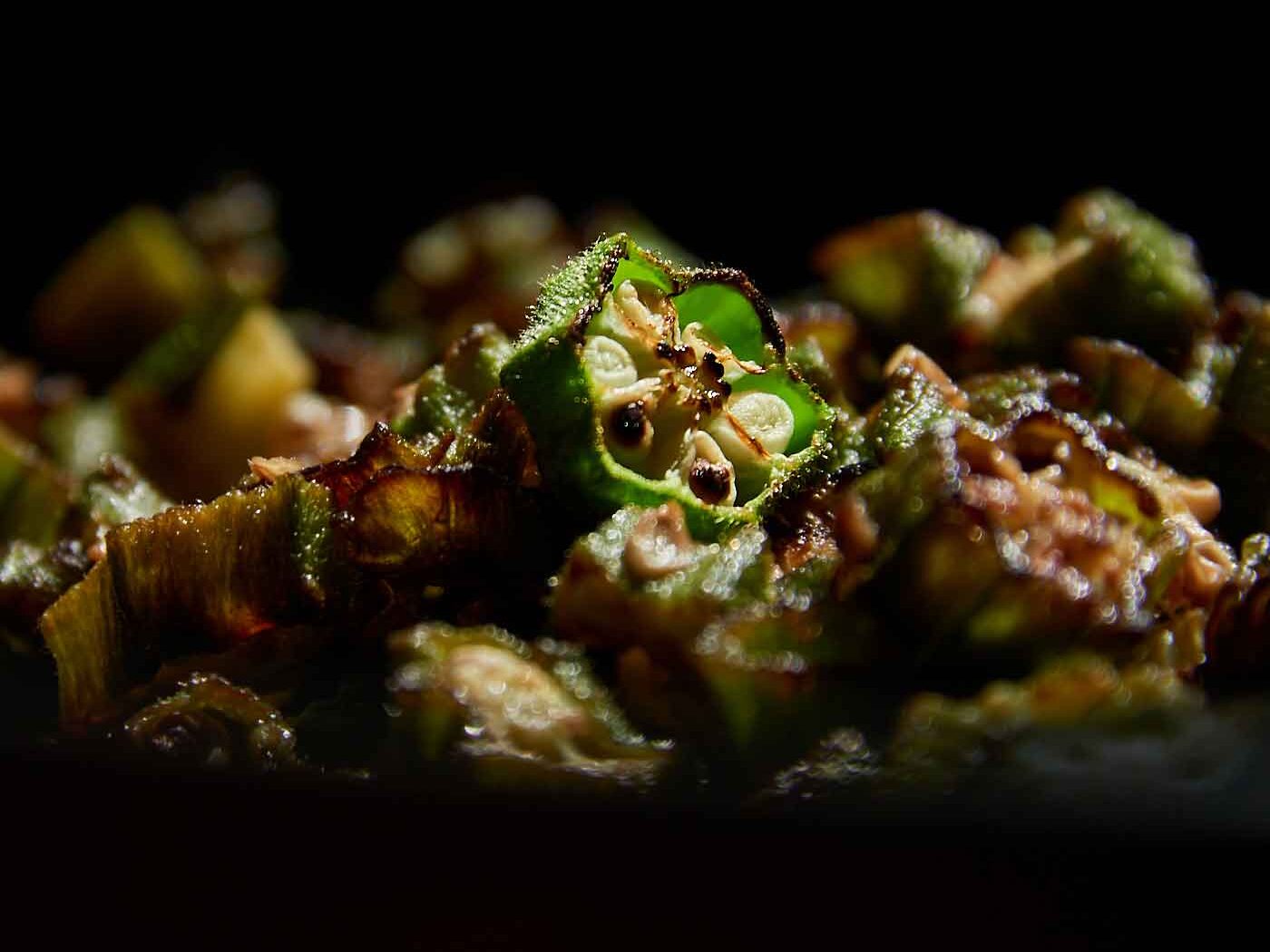
Frequently Asked Questions
There are a number of steps and ingredients in this dish that when used correctly, build so much depth and flavor.
1. Stock/Broth: For starters, having flavorful stocks/broths are an immediate way to make a better soup or stew. You can certainly buy boxed broths. However, if you make stock from scratch, don’t skimp on flavor. Shrimp heads and roasted chicken skin are where the most concentrated flavors are located. Do not throw them out if you can avoid it; freeze them if you can’t use them immediately.
If you cannot find shrimp with the heads still attached, you will need to at least double the shrimp tails to get a similar flavor, but it can be done. Uncooked chicken can be used for a homemade stock, but it won’t be as flavorful. Make a roast chicken or even buy a fresh rotisserie chicken and then use those leftovers for your soup base. Honestly, WORLDS of difference.
Did you know?: Stock is traditionally made from just bones and broth is made from meat/skin. Purchase accordingly if you are using store bought. My stocks are a hybrid because no way am I just boiling bones.
2. Umami bombs: Miso paste, anchovy, and garlic all add the savory/bright elements to this gumbo, that we lovingly call umami, so that it doesn’t hit your palette flat. Adding them after sweating out the mirepoix but before adding in any straight liquids allows them to permeate the oil in the roux better than if you added them later. (Same goes for the spices.)
3. Toasty things: The very deep toasted flavor that permeates this stew comes from two places. The dark “chocolate colored” roux and the ale. The work you did to toast the flour in oil and then simmer the stew until the flour flavor cooks out, only means one thing. Just the toasty flavor remains. Yum! In addition the bready yeast flavor with slight malt from the ale, gives this stew an added deepening element. Also, if you are nervous, alcohol fully cooks out of a simmering stew in 3 hours.
4. The Maillard reaction: Sauteéing the sausage and the okra, even allowing them to char a bit, layers flavor. Consider, for those of you who have eaten hot dogs, how different a boiled versus grilled hot dog tastes.
5. Adding alcohol: I picked up this trick from J. Kenji López-Alt and his short rib chili recipe. When alcohol evaporates it traps more aroma than regular steam making our food taste that much better. (This is 100% optional)
Did you know?: Even though our taste buds deliver more intense flavor than our olfactory receptors, aroma actually delivers 80% of what we perceive as flavor.
Traditionally, the roux, the okra, and the filé thicken a gumbo. Roux is always used, but sometimes okra and filé are not. I do use all three in this recipe. However, I cook off most of the thickener in the okra in favor of their browned flavor. I have never regretted this decision and find the gumbo plenty thick for my tastes.
A roux is equal parts, by weight, fat to flour. To convert, 1 cup or 240ml (both volume) of oil weighs roughly 215 grams so I used 1 1/2 cups of flour (volume again) which weighs about 205g. Because of the high heat used for making dark roux, make sure to use an oil that has a high smoke point. Canola oil, vegetable oil, peanut oil, and grapeseed oil are all great options.
If you decide you want to have okra be a part of the thickening party, simply add the uncooked slices at the same point as the cooked ones in the recipe. Sauté for just a bit (until they soften and get slimy) and then add in the beer and the stocks as written. (If you are looking to lessen the amount of roux for dietary purposes, I would suggest halving the roux and using okra in this way, instead of as written in the recipe.)
finally, the filé must be added at the end for the most and best impact to texture. If you add it while the stew is still boiling it can impart a stringy texture. If that happens, not to worry, just keep cooking the gumbo down. Of note, the more you cook the filé the less it works and flavors the gumbo, so you’ll lose the the raw vegetal flavor it imparts when you don’t cook it as well as the glossy thickening action. It tastes actually quite nice, like thyme and tea leaves with a hint of citrus.
You may see some recipes start the dark roux from a cold or just warm pan and then increase the temperature little-by-little. I’ve not had great results from this, mainly because it takes forever and I am impatient but also because there is a longer window for me to mess things up. Oh wait those are the same thing! 😛
I prefer to start the oil hot and have it immediately begin toasting the flour. Seriously, within 15 minutes you will go from a white roux (completely uncooked) to a deep chocolate brown color. You’ll know the roux is burned if you see black flecks or chunks that are much darker than the rest of the roux and it has taken on a bitter, acrid smell. But, how much better would you feel about starting over on something that takes 15 minutes as opposed to 1+ hours.
I do recommend, using an enameled dutch oven as it holds heat better and won’t have hot spots to scorch your roux like a metal stock pot might. If you are using metal, I suggest keeping everything at medium high to be on the safe side. I also recommend using a wooden spatula. Utensils encased in silicone or with many parts, like a whisk, can volatilely affect the surface of the roux, which means spatter. And, let me tell you, oil this hot immediately blisters on impact. No thanks!
Since you will surely have different sizes of shrimp in your batch let me just give you visuals to look out for.
1. The shrimp should turn pink/orange in color fro their uncooked gray. I know an easy one.
2. They should also never be cooked past a gently curled “C” shape. Once they curl tightly against themselves they are the texture of rubber. Don’t let it get that far.
3. Finally, even if you only put the shrimp in at the very end, that stew is hot. They will over cook in a matter of minutes. Cook them and then set them aside to be added back in at serving.
This is extremely helpful when reheating leftovers, as they can be brought to temperature in the already hot stew and not overcooked in the microwave or on the stove during the process.
Easy answer, to cook out the flour flavor. Do me a huge favor and do try the gumbo before and after it simmers for a few hours. You will be AMAZED at the difference!
You can store gumbo in an airtight container, in the refrigerator, for up to 4 days. I do not recommend adding the shrimp into the gumbo before freezing as they will overcook when you reheat the stew. Just sauté up some fresh shrimp for that meal or go without them.
The gumbo will keep for up to 4 months in the freezer. Defrost frozen gumbo on the stovetop in a lidded soup pot or larger saucepan on low. Freezing will already have softened the cell walls of any vegetables in your gumbo. Reheating in a microwave tends to dissolve vegetables even more because of its rapid heating and such an immediate change in state.


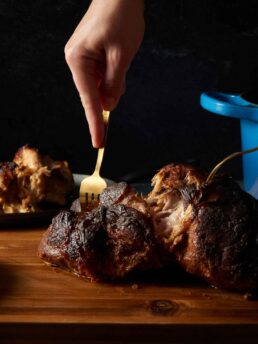
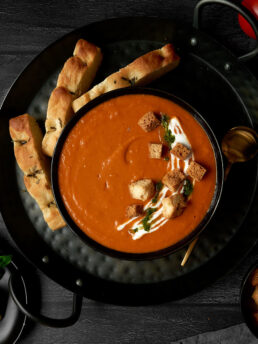
That’s some high praise! Thank you so much for sharing!